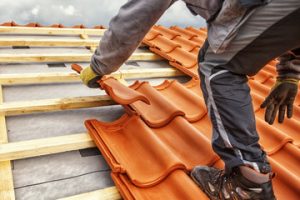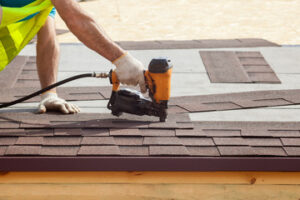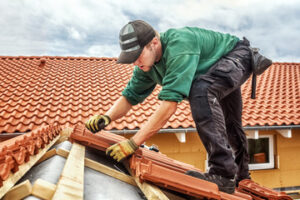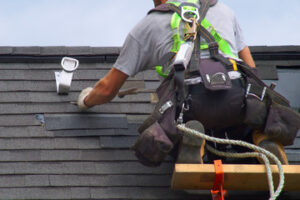A new roof offers several perks to homeowners, including higher resale value. It can also save money on energy bills.

Roofers begin by removing the old materials, laying new underlayment and installing fresh shingles or panels. They also install flashing around sanitary stacks and vents to ensure that leaks are prevented. Contact Roof Replacement Erie PA for professional help.
A roof is a big investment, so it’s important to have a good understanding of the costs involved with your specific roofing project. This will help you make an informed decision about whether to repair or replace your roof, and which roofing materials are best for your home’s needs.
The cost of the replacement materials is a major factor in determining your roof’s overall cost. Basic asphalt shingles are the most affordable option, but premium materials like metal or slate are also available and may be worth the extra expense in terms of longevity and aesthetics.
Other important factors include the size of your roof and its complexity. Larger roofs require more material and labor, driving up costs. Additionally, roofs with steep pitches are more challenging to work on and require additional safety measures, which add to the total cost.
Another important consideration is the extent of your existing roof’s damage. Minor issues like a few missing shingles can be repaired for as little as $150, but widespread damage will likely require a full roof replacement. A professional can often identify this type of damage by simply walking around the property, or with the use of moisture-detecting equipment.
Aside from the cost of the replacement material, you’ll need to budget for additional expenses like labor, permits, and disposal of the old materials. You’ll also need to consider whether any repairs or replacements of your existing gutters and flashing are necessary, as these can increase the overall cost of the project.
In addition to these cost factors, your roofing contractor will also take into account the current condition of your existing roof. For example, if the substrate materials, such as the wood decking and sheathing, are showing significant wear or have been compromised by water or impact damage, these will need to be replaced as well.
Once you’ve determined the scope of the project, your roofing contractor will prepare a detailed estimate for you. They’ll begin by measuring your roof and performing a thorough inspection. During this process, they’ll identify any areas that need special attention and explain different roofing materials and warranties to you.
Materials
The material used for a roof is an important decision that impacts the durability, appearance, and energy efficiency of your home. There are a variety of highly durable options to choose from, each with its own unique advantages and disadvantages. The type of roof material you choose should reflect the climate in your area, as well as your lifestyle and budget.
Asphalt shingles are the most popular roofing option due to their affordability, ease of installation, and range of colors and styles. They also provide good heat resistance and are highly durable against storms, hail, and wind. If you’re looking for a more elegant look, consider metal roofing. It’s a strong and long-lasting alternative to traditional shingle roofing, and comes in a variety of different metals and finishes to complement any architectural style.
If you’re interested in a more natural option, wood shingles and shakes offer a combination of beauty and durability. Made from natural cedar or redwood, they’re available in a variety of thicknesses and textures to suit your aesthetic preferences. They are also weather-resistant and can last up to 30 years if properly maintained.
Concrete tiles are another excellent roofing choice, offering an attractive, Mediterranean-style look that is both fire and water resistant. They’re a great alternative to clay tiles, which are often pricier but require more maintenance and have a tendency to crack in cold temperatures.
In addition to your roof, there are other elements of the roof that need attention during a replacement, including the gutters and soffits. The soffit is a vented structure that helps prevent moisture, which can cause damage to the roof deck and deteriorate insulation. Replacing the soffit is a relatively inexpensive project that can be done by any roofing contractor.
The gutters are responsible for directing water away from the roof’s edge, so it’s important to have them in working condition. If they’re clogged with leaves or debris, it’s important to have them cleaned regularly and replaced when needed. Also, the drip edge should be in good condition to ensure that rainwater is directed away from the foundation of your home.
Installation
In addition to repairing or replacing damaged shingles, roof replacement may include upgrading the appearance of your home, adding energy-efficient materials, or introducing a skylight. Homeowners should carefully consider these options before committing to a roof replacement project. It is also important to choose a roofing contractor that is qualified and experienced.
Before starting any physical work, a roofing professional will inspect your roof and note the size and condition of your current shingles. They will then discuss your options and preferences with you. For example, homeowners may decide to opt for a slate roof that provides upscale aesthetics and durability, or wood shakes that offer rustic charm. Lastly, they can add vents for better attic ventilation and airflow and replace gutters to prevent leaks.
During the installation process, roofers will remove the existing shingles and underlayment to expose the roof deck. They will then install a new layer of underlayment to create a water barrier and protect the decking from moisture. Metal flashing will be installed around critical areas such as chimneys, wood stove pipes, vents, and roof valleys. It will also be applied along hip and ridge roofs to provide additional protection against water intrusion.
Finally, a new layer of shingles will be installed. The final step involves the removal of any remaining debris and a final inspection. During this stage, the contractor will ensure that all of the shingles lay flat and evenly and are free from any creases or curling. They will also sweep up any nails that have fallen off during the process and clean up the area surrounding your home.
Aside from the cost of materials, other factors that can affect the total cost of a roof replacement include roof size, labor costs, and local construction rates. For this reason, homeowners are encouraged to get multiple quotes from reputable roofing contractors. Choosing the right roofer will help homeowners stay within their budgets while ensuring that their roof is properly installed and protected against leaks and other issues. The best way to reduce the overall cost of a roof replacement is to contact an insurance provider and see if they cover the damage caused by storms or other natural disasters.
Warranty
A roof warranty is a safeguard against unexpected expenses after a reroofing project. Many manufacturers and contractors offer warranty programs for their roofing products, which vary in terms of duration, coverage, and what is considered a defect. It is important for homeowners to familiarize themselves with the details of these warranties to make informed decisions about materials, installation, and long-term maintenance.
Understanding the different types of roofing warranties available will help you determine which one best suits your needs. The most basic warranty is a manufacturer’s material warranty, which covers defects in roofing materials such as shingles or membranes. This type of warranty typically lasts 20 to 50 years. It is possible to get an extended warranty from the manufacturer for a larger investment, which provides even more coverage.
Another type of warranty is a workmanship warranty, which is provided by the contractor who installs the roofing system. It ensures that the work done meets industry standards and that any issues resulting from the installation will be taken care of. The length of a workmanship warranty can vary, but it is often shorter than a manufacturer’s warranty.
Some warranties also cover damage caused by natural disasters or severe weather events. However, it is important to read the fine print and understand any exclusions or limitations that may apply. It is also a good idea to ask about the deductibles, which will determine how much you will have to pay in case of a claim.
Whether you choose to go with a pro-rated or non-pro-rated warranty for your new roof will also affect the cost and long-term value of the project. Pro-rated warranties have a lower upfront cost but decrease in value over time, which could result in significant out-of-pocket costs for future repairs. Non-pro-rated warranties, on the other hand, have a higher initial investment but provide consistent, long-term coverage.
A good roof warranty is an excellent selling point for roofing contractors and can boost customer confidence in their services. Keeping records of inspections, maintenance, and repair will help you maintain your warranty. It is also important to make sure that you contact your warranty provider if any problems occur. This will ensure that you receive proper attention and support, which is essential for protecting your investment.


